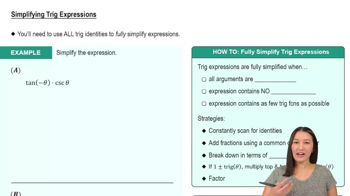Table of contents
- 0. Functions7h 52m
- Introduction to Functions16m
- Piecewise Functions10m
- Properties of Functions9m
- Common Functions1h 8m
- Transformations5m
- Combining Functions27m
- Exponent rules32m
- Exponential Functions28m
- Logarithmic Functions24m
- Properties of Logarithms34m
- Exponential & Logarithmic Equations35m
- Introduction to Trigonometric Functions38m
- Graphs of Trigonometric Functions44m
- Trigonometric Identities47m
- Inverse Trigonometric Functions48m
- 1. Limits and Continuity2h 2m
- 2. Intro to Derivatives1h 33m
- 3. Techniques of Differentiation3h 18m
- 4. Applications of Derivatives2h 38m
- 5. Graphical Applications of Derivatives6h 2m
- 6. Derivatives of Inverse, Exponential, & Logarithmic Functions2h 37m
- 7. Antiderivatives & Indefinite Integrals1h 26m
- 8. Definite Integrals4h 44m
- 9. Graphical Applications of Integrals2h 27m
- 10. Physics Applications of Integrals 2h 22m
1. Limits and Continuity
Finding Limits Algebraically
Problem 76b
Textbook Question
Explain why lim x→3^+ √ x−3 / 2−x does not exist.
 Verified step by step guidance
Verified step by step guidance1
Consider the limit \( \lim_{{x \to 3^+}} \frac{\sqrt{x-3}}{2-x} \). We need to analyze the behavior of the function as \( x \) approaches 3 from the right.
As \( x \to 3^+ \), the expression \( \sqrt{x-3} \) approaches \( \sqrt{0} = 0 \) because \( x-3 \) becomes a very small positive number.
Simultaneously, as \( x \to 3^+ \), the expression \( 2-x \) approaches \( 2-3 = -1 \), which is a negative number.
The fraction \( \frac{\sqrt{x-3}}{2-x} \) thus approaches \( \frac{0}{-1} = 0 \) from the positive side, but the denominator is negative, indicating a sign change.
Since the denominator approaches a negative value and the numerator approaches zero, the limit does not exist because the function approaches different values from different sides of 3.
 Verified video answer for a similar problem:
Verified video answer for a similar problem:This video solution was recommended by our tutors as helpful for the problem above
Video duration:
5mPlay a video:
Was this helpful?
Key Concepts
Here are the essential concepts you must grasp in order to answer the question correctly.
Limits
In calculus, a limit describes the behavior of a function as its input approaches a certain value. It helps in understanding how functions behave near points of interest, including points where they may not be defined. The notation lim x→c f(x) indicates the limit of f(x) as x approaches c, which can be from the left (c^-) or the right (c^+).
Recommended video:

One-Sided Limits
One-Sided Limits
One-sided limits are limits that consider the behavior of a function as the input approaches a specific value from one side only. The right-hand limit, denoted as lim x→c^+ f(x), examines the function as x approaches c from values greater than c. If the one-sided limits do not match or do not exist, the overall limit at that point does not exist.
Recommended video:

One-Sided Limits
Undefined Expressions
An expression is considered undefined when it leads to a situation that cannot be resolved mathematically, such as division by zero. In the context of limits, if the function approaches a form like 0/0 or ∞/∞, it indicates that the limit may not exist. Understanding how to identify and analyze these forms is crucial for determining the existence of limits.
Recommended video:

Simplifying Trig Expressions

 5:21m
5:21mWatch next
Master Finding Limits by Direct Substitution with a bite sized video explanation from Callie
Start learningRelated Videos
Related Practice







